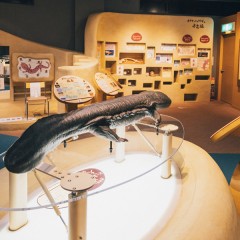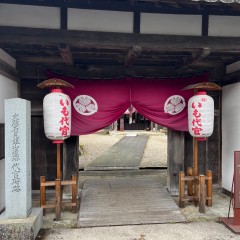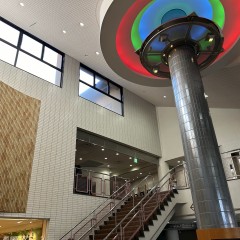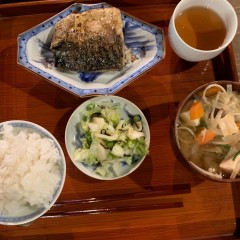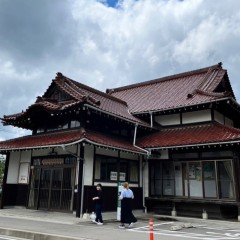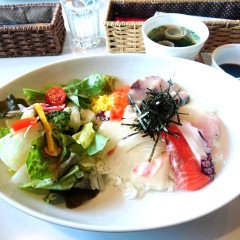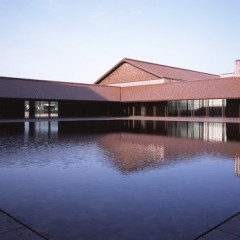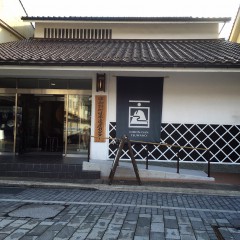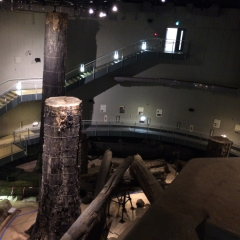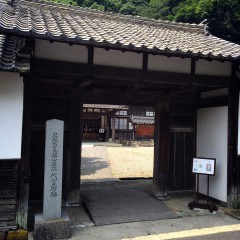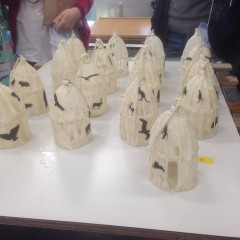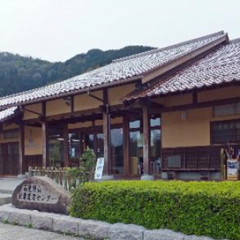Sekisho Art museum
 This museum was built for Sho Ishimoto(石本正) who is a famous Japanese artist. He sent his works to Misumi and this museum was built in 2000. He wants this museum not to keep up with current fashion, but to instead be an intimate museum with the beautiful forest of Misumi, old temples, and so on. He was born in Misumi, Shimane in 1920. He learned art in Kyoto, where he has a studio, and he is a professor at the Kyoto University of Art and Design now.
This museum was built for Sho Ishimoto(石本正) who is a famous Japanese artist. He sent his works to Misumi and this museum was built in 2000. He wants this museum not to keep up with current fashion, but to instead be an intimate museum with the beautiful forest of Misumi, old temples, and so on. He was born in Misumi, Shimane in 1920. He learned art in Kyoto, where he has a studio, and he is a professor at the Kyoto University of Art and Design now.
 After his painting “Three girls(三人の少女)” won a prize at the Japanese Art exhibition, he became famous. After that he won the same prize twice again, and one of his paintings “scenery(風景)” not only won the prize of the Kyoto exhibition but also was bought by an art museum in Kyoto. It made him more famous. But after he was awarded the Japan Art Grand Prix and the Agency of Cultural Affair in 1971, he refuses to get any prize or to be interviewed by the media. But still his work affects many artists and students.
After his painting “Three girls(三人の少女)” won a prize at the Japanese Art exhibition, he became famous. After that he won the same prize twice again, and one of his paintings “scenery(風景)” not only won the prize of the Kyoto exhibition but also was bought by an art museum in Kyoto. It made him more famous. But after he was awarded the Japan Art Grand Prix and the Agency of Cultural Affair in 1971, he refuses to get any prize or to be interviewed by the media. But still his work affects many artists and students.
Although he draws many kinds of things, for example women, plants, scenery, animals and  so on, he is famous for drawing maiko(舞妓), and especially nude women. The reason why he began to draw maiko was the influence of Ryusei Kishida. Kishida is a really famous Japanese artist. His works have one characteristic, which is not drawing things or people so beautifully. We can see this influence on Mr. Ishimoto’s work. He thought living things and their beauty are short-lived and what they have is not only beauty. So his paintings of maiko show emphasize not only their beauty, but also their freshness and purity.
so on, he is famous for drawing maiko(舞妓), and especially nude women. The reason why he began to draw maiko was the influence of Ryusei Kishida. Kishida is a really famous Japanese artist. His works have one characteristic, which is not drawing things or people so beautifully. We can see this influence on Mr. Ishimoto’s work. He thought living things and their beauty are short-lived and what they have is not only beauty. So his paintings of maiko show emphasize not only their beauty, but also their freshness and purity.
Why did Mr. Ishimoto begin to draw nude women? During the war, he saw a mother nursing on the train. His thoughts returned to her cleavage shining, so his next painting featured a nude woman’s cleavage shining. He hopes to show the warmth of human beings, the symbol of mother hood, and source of living things though his nude paintings.
But he was sometimes criticized for his nude paintings and this made him worry. When he published the “maiko” in 1966 he became even more worried. The painting features three maiko who are not so beautiful, but pure and fresh, and it also depicted four other nude women, but he erased them because people didn’t understand his work and criticized it a lot. So in 1968 he produced another “maiko,” different from the one made in 1966. The 1968 version includes three maiko and they are all drawn beautifully.
After that he worried that there were differences between what he wanted to draw and what people wanted to see, so he began to draw many things and he went to Kyoto with Matazo Kayama to sketch. He drew many maiko sketches, but when he transferred the real women to his canvas, he often changed their appearance. Perhaps, if the m aiko was not rich, he would draw her in a really expensive kimono, with beautiful combs, and he would even draw their faces from his own imagination instead of from reality.
aiko was not rich, he would draw her in a really expensive kimono, with beautiful combs, and he would even draw their faces from his own imagination instead of from reality.
In Kyoto he met one maiko, Toyochiyo. She was regarded as a most beautiful maiko then. Her department store posters were always stolen, showing how she was beautiful and popular. He began to sketch her, but he thought she was too beautiful to draw on canvas. After his trip to Europe to draw and see European arts, he tried to draw Toyochiyo on canvas, many years after he first sketched her.
 One very interesting painting in this museum is called “Resurrection.” You must not miss it! It was copied by Tadao Okazaki, who was coached by Mr. Ishimoto. He was really inspired by the original “Resurrection” by Piero della Francesca. Although it was forbidden to copy pictures, to prevent some people from selling these imitations in Italy, Okazaki really wanted to do another version so he asked to copy this picture. With his zeal, he got permission to copy it in a larger size, so he moved to Italy with his family and worked on his copy in front of the original picture for five years. For this exhibition, Japanese cutting-edge technology is used. There is a glass in front of the picture, but it never prevents you from enjoying this picture. The glass and the light used in the display are special ones. This picture and these technologies will impress you for sure.
One very interesting painting in this museum is called “Resurrection.” You must not miss it! It was copied by Tadao Okazaki, who was coached by Mr. Ishimoto. He was really inspired by the original “Resurrection” by Piero della Francesca. Although it was forbidden to copy pictures, to prevent some people from selling these imitations in Italy, Okazaki really wanted to do another version so he asked to copy this picture. With his zeal, he got permission to copy it in a larger size, so he moved to Italy with his family and worked on his copy in front of the original picture for five years. For this exhibition, Japanese cutting-edge technology is used. There is a glass in front of the picture, but it never prevents you from enjoying this picture. The glass and the light used in the display are special ones. This picture and these technologies will impress you for sure.
In this museum, there are lots of events and the exhibitions often change. (You can see Sho Sekimoto’s work. And sometime it’s closed while they prepare for the next exhibition.) Some events are free and sometimes artists will come to talk about art. You can also enjoy crafts and the occasional music recital. There are classes for sketch, water and oil paintings and so on. If you want take these classes, sometimes you need reservations. Please check Sekisho Art museum’s HP.
There is a Café in the same building. You can have lunch there. Check this page.
Address : 589, Koichiba, Misumi-town, Hamada-city, Shimane
TEL : 0855-32-4389
E-mail : sekisho@mx.miracle.ne.jp
HP : http://fish.miracle.ne.jp/sekisho/
Business time : 9:00~17:00
※ This museum is not open every Monday and the end of the year and the new year.
(When Monday is the day of holiday, it’s not open on next Tuesday. )


